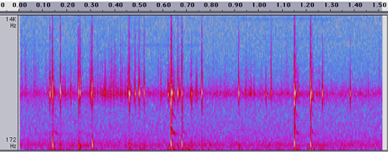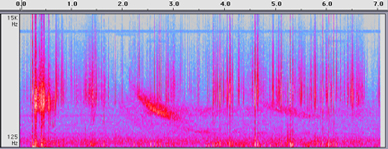


| |
 |
|
| HOME ABOUT INSPIRE VLF-3 RADIO RECEIVER KIT NATURAL VLF RADIO COLLEGE/UNIVERSITY SCHOLARSHIPS NASA GODDARD INTERNSHIPS INSPIRE JOURNAL RESEARCH & SCIENTIFIC PUBLICATIONS EMAIL SIGN-UP FAQ CONTACT The INSPIRE Project, Inc. 107 S West Street PMB #425 Alexandria, VA 22314-2824 [email protected]
|
Types of VLF Signals | NATURAL VLF RADIO Sample Natural Radio Signals The source of most natural radio signals is lightning. When a lightning bolt strikes, a massive amount of charge is moved and this acts in much the same way as moving charge in a radio transmitting antenna. The frequencies emitted by lightning range from 0 Hz to over 100 kHz with all frequencies being emitted simultaneously with the visible flash of lightning. In just a little over 1 second, more than 20 tweeks appear. Dispersion is shown by the "hooks" on the sferics at about 2 kHz. Stronger tweeks also show hooks at harmonics (multiples) of 2 kHz. A burst like this would sound like a rapid succession of sharp ringing sounds.The lightning signal, when received and amplified, sounds like a dry crackling sound like the popping of a campfire. These sharp, popping emissions are called "sferics", from atmospherics. Figure 1 shows a frequency-time spectrogram of several sferics. The vertical lines in the spectrogram illustrate that a sferic consists of a wide range of frequencies received simultaneously resulting in the dry, popping sound referred to as static. Vertical lines indicate the presence of all frequencies. The design frequency range of the receiver is 0-10 kHz. Horizontal lines appearing between 10 kHz and 15 kHz are signals from the Russian ALPHA navigation system. Even though they are higher frequency than the design of the receiver they are still sometimes detected because of their high signal strength. In this 10-second interval there are over 20 strong sferics and numerous weaker ones. This would be considered quiet conditions. Sferics from lightning as much as 2000 to 3000 kilometers away can be detected by the VLF receiver even though an event that far away is occurring well over the visual horizon. This is because VLF radio waves commonly reflect off a layer of charged particles (electrons) in the ionosphere redirecting the signal back toward the surface of the earth. The signal can then bounce off the surface of the earth, and again off the ionosphere, with this process repeating as the signal is carried around the earth. This process can sometimes carry the VLF wave more than half way around the earth. When the sferic signal travels a long distance it undergoes dispersion. That is, the higher frequencies travel slightly faster than the lower frequencies and therefore arrive at the receiver slightly ahead of the lower frequencies. The lower frequencies lag only a few hundredths of a second, but that makes a big difference in how the signal sounds and also leaves a characteristic imprint on the spectrogram. The sound heard is modified by dispersion from the dry popping sferic so that it has a pronounced ringing nature. This is called a "tweek". Figure 2 shows the spectrogram of several tweeks. Figure 2: TWEEKS   Another interesting natural radio emission is called a "whistler". Figure 3 shows the spectrogram of several whistlers that sound like a smoothly descending tone when received and amplified. Figure 3: WHISTLERS 
 A whistler appears at 5 seconds and a stronger one appears at 13 seconds. The sweeping curve is the signature of a whistler. The dispersion of the signal is almost 3 seconds. The horizontal dashes just above 10 kHz are from the now-inactive OMEGA navigation system. ~ Bill Pine, Co-Founder Emeritus, The INSPIRE Project, Inc. |
 |
| The INSPIRE Project, Inc is a non-profit scientific educational corporation that provides engaging opportunities for students
to observe naturally occurred Very Low Frequency (VLF) waves generated by lightning and in the process gain hands-on, real world experience in science and electronics. It seeks to enhance educators knowledge of atmospheric and space science
to encourage our next generation of scientists. INSPIRE’s educational platform serves a wide range of science, technology,
engineering and math (STEM) topics and programs.
© 2024 The INSPIRE Project, Inc. |
|